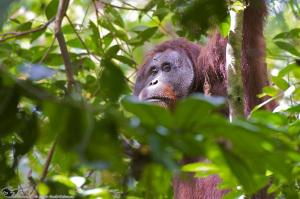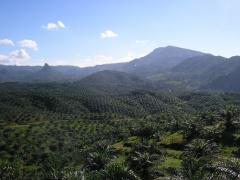Here’s a post from one of our lab’s post-doctoral fellows, Dr. Stephen Gregory. Stephen just got back from Borneo (jammy bastard), and will now regale you with his exploits.
–

© Danau Girang Field Centre
When asked to name a Bornean animal, I’ll bet the Bornean orangutan (Pongo pygmaeus) would top a public survey. This charismatic animal shares over 95 % of its genome with Homo sapiens, and so it’s little wonder that we find their infants so adorable and their popularity in the pet trade so deplorable.
Yet, I wonder how many people know that the biggest threat to our hairy red cousin is actually human eating and hygiene habits? Palm oil (oil extracted from the kernel of Elaeis spp.) is used in many foods – particularly snack foods – and hygiene products. It is our addiction to these convenient products that is destroying the orangutan’s habitat.
I’ve just returned from a trip to Sabah, the northernmost Malaysian state on Borneo, where I witnessed this distressing truth firsthand. I was meeting with the Sabah Wildlife Department, French NGO Hutan and staff at the Danau Girang Field Centre to discuss early results from my Sabah orangutan project and seek their expert opinions.

On the drive from Kota Kinabalu to the Lower Kinabatangan, I encountered firsthand the sheer scale of the oil palm industry in eastern Sabah. It was shocking. It can only be described as a sea of oil palm that stands where primary and even secondary forest formerly flourished.
Before I continue, I hasten to highlight that the deforestation situation in Sabah has improved dramatically in recent years. Approximately 50 % of Sabahan forest is still standing and the Sabah government is committed to ensuring that it stays standing into the foreseeable future.
Orangutans are not known to use the oil palm plantations for shelter or food. Although they should be able to cross it to reach small forest fragments, those fragments are few and far between and dispersing individuals will have high mortality. In essence, the oil palm is uninhabitable and renders isolated forest fragments unreachable, thereby reducing the orangutan distribution to a small, vulnerable, interconnected network of forest reserves.

© Danau Girang Field Centre
Orangutans can be considered an umbrella species; Bornean elephants (Elephas maximus borneensis) share the same small forest networks; Sumatran rhinoceros (Dicerorhinus sumatrensis) are confined to forest habitat and are in serious threat of extinction, the fate met by the Sumatran tiger (Panthera tigris sumatrae) on Borneo.
What of the smaller animals and birds? Surely they can survive in oil palm plantations?
Oil palm is very productive and so very popular. It can be grown in vast monocultures and produces kernels multiple times a year, for up to 25 years. It is at the end of 25 years, however, that the most devastating consequences of the palm oil industry are felt by smaller animals and birds; old unproductive palms are felled in huge numbers, exposing all former inhabitants to predators and deadly climate conditions.
In collaboration with Sabah Wildife Department, Hutan and Danau Giring Field Centre and the Borneo Conservation Trust, the Global Ecology Lab of The University of Adelaide is working to understand where and how the network of forest fragments in eastern Sabah can be reinforced to secure the orangutan population in the future. Furthermore, we’ll investigate how the proposed plans can benefit other Bornean animals and plants.
My 3-day trip to the DGFC in the centre of this forest fragment network turned up elephants, orangutan, reticulated pythons, civets, slow loris, proboscis monkeys, macaques, horseshoe and fruit bats, innumerable birds and plants and some spectacular insects, lizards and frogs. If the Sabah government can safeguard its forests as it plans and small forest fragments can be reconnected, then I believe that many Sabah’s most quintessential wildlife can maintain a stronghold. Who knows? Perhaps Sabah might be a role model for the rest of Borneo?
Stephen Gregory
-34.917731 138.603034
